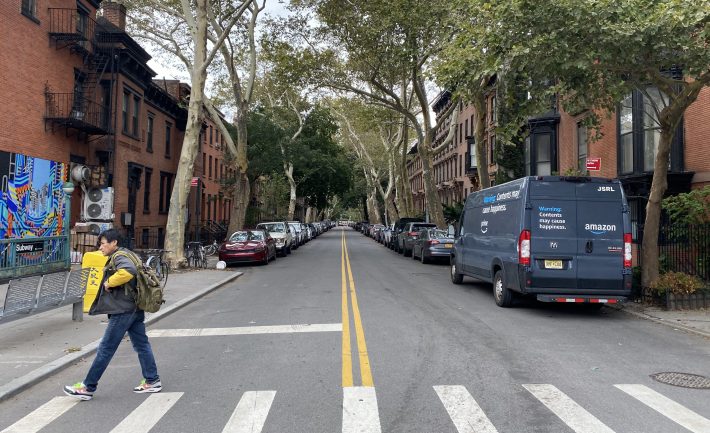A block-long "open street" on South Portland Avenue that once hosted rollicking dance parties next to Fort Greene Park abruptly ended this spring after the Department of Transportation reassigned contractors to street closures elsewhere in the city, Streetsblog has learned.
The block between Lafayette Avenue and Fort Greene Park had limited access for motor vehicles from May 2020 early in the pandemic until this past April when DOT pulled its personnel and left volunteers to try and fail to pick up the slack, according to local organizers.
Regular traffic returned to the block this May, but the open street remained listed on DOT's website as late as mid-September before it quietly disappeared with no public announcement or notice by the agency.
“It is disappointing and it proves how you have to really fight for the good things,” said Phillip Kellogg, a volunteer with the Fort Greene Open Streets Coalition, which originally oversaw three open streets in the neighborhood, including South Portland Avenue, Willoughby Avenue and Hall Street.
The Fort Greene volunteers first got wind in March from DOT and its contractor for public space maintenance, the Horticultural Society of New York, or Hort, that the staff moving the barriers to block drivers would be reassigned.
DOT officials told Streetsblog this week that the block no longer qualified for the agency's Public Space Equity Program designed to fund open streets in needier parts of the city where local organizations might struggle to maintain the spaces themselves. The support initiative is limited to just 30 locations citywide.
Locals could still apply for an open street, said DOT spokesman Scott Gastel, but the agency decided to shift its support workers to “higher-need, more active locations."
"This organization, or any other, is welcome to apply for an Open Streets on South Portland Avenue in the future," Gastel said in a statement.
During this year's application process and before removing the Hort staff, DOT had cut the open street’s hours in half for the 2023 season — from its previous 24/7 operation to 12 hours a day, according to organizers.
Residents tried to rally neighbors to help out instead, scaling the hours back further to just weekends. Even keeping that going proved too much. One unknown neighbor even went rogue and set up the barriers during the week as well, cutting through the bike lock to do so, according to the local volunteers.
“Somebody had been freelancing, if you will, putting out barriers during the week,” said Kellogg. “So somebody didn’t agree with the DOT situation.”

The last-ditch efforts faltered by May, when the open street died, Kellogg said.
“There wasn’t really a volunteer infrastructure in place,” he said. “It was just too much, which just speaks to [the fact that] that a permanent city program needs city resources and [to] not rely on volunteers.”
Locals didn’t always realize the street was open again to full traffic, leading some to still walk in the street, according to another volunteer who called that transition period a “Wild West situation.”
“We had a very dangerous period where we had no real notice from DOT that a change had occurred,” said Brian Blessinger. “There were people just walking up and down the block.”
Another open street on Hall Street, between Park and Myrtle avenues, is also no longer active, despite still being listed online by DOT as of Friday.
The stretch has been inactive for months, Blessinger said, and was always hard to keep free of drivers, with its busy location right near the elevated Brooklyn-Queens Expressway.
“People almost rammed through the barricade,” said Blessinger.
That leaves just one of three open street intact in the neighborhood, Willoughby Avenue, which was infamously shut down and then restored at the beginning of the Adams administration — reportedly following orders from the mayor’s second-in-command advisor and frequent street safety foe Ingrid Lewis Martin.
The area's Council Member Crystal Hudson has raised concerns about Willoughby Avenue, asking DOT in 2022 to reassess the corridor's redesign to accommodate "the needs of all members of the community."
Thursday night at a meeting dubbed the "The Downside of Vision Zero," the lawmaker tried to placate both-sides the street safety debate in her district and revealed that she canceled a community meeting about the embattled Underhill Avenue bike boulevard after hearing that "pro-bike folks and bike lane folks" were going to attend.
Local open streets volunteers hadn't heard of any notable opposition to South Portland Avenue's open street, and Hudson did not respond to a request for comment on its demise.
South Portland’s open street originally extended just shy of Atlantic Avenue at South Elliot Place and, along with Willoughby, provided two car-less arteries out of Fort Greene Park.
"You should have seen people come down this block, their eyes lit up," said South Portland Avenue resident Van Le. "I definitely miss it."
Here's what one block party looked like two summers ago.
DOT has converted some open streets into permanent redesigns that don't lean on volunteers. The overhauls have run the gamut from adding daylighted corners and some extra pedestrian spaces on a block of W. 22nd Street in Manhattan to a wholesale reimagining of more than a mile of 34th Avenue in Queens with car-free plazas and flipped traffic blocks to reduce traffic.
The overall number of open streets had already dropped a year ago from its peak of 83 miles to just 20 miles, though DOT boasted nearly 200 locations for this year's season.
Keeping the momentum going in year three of the pandemic has been challenging without outside help, said one urban planner and former local open streets volunteer.
"More than anything there was just a burning out of neighbors," said Mike Lydon, who founded the urban planning organization Street Plans.
“It just shows that gap between what was used successfully during the pandemic to making that a larger, more sustained program,” he added. “I fear that other locations sputtered out due to that gap.”






